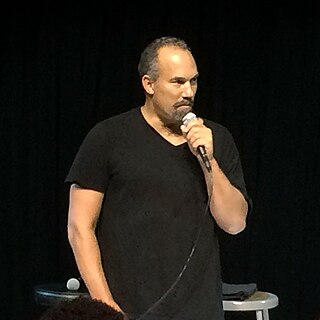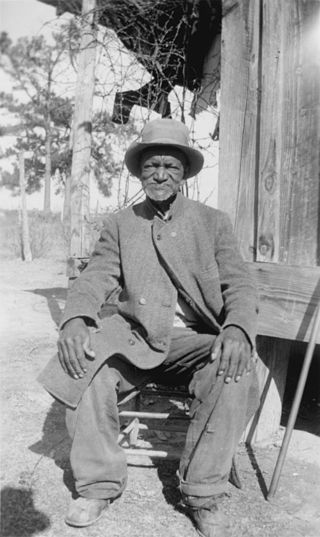The slave narrative is a type of literary genre involving the (written) autobiographical accounts of enslaved Africans, particularly in the Americas. Over six thousand such narratives are estimated to exist; about 150 narratives were published as separate books or pamphlets. In the United States during the Great Depression (1930s), more than 2,300 additional oral histories on life during slavery were collected by writers sponsored and published by the Works Progress Administration, a New Deal program. Most of the 26 audio-recorded interviews are held by the Library of Congress.

The Underground Railroad was a network of secret routes and safe houses established in the United States during the early to mid-19th century. It was used by enslaved African Americans primarily to escape into free states and from there to Canada. The network, primarily the work of free African Americans, was assisted by abolitionists and others sympathetic to the cause of the escapees. The slaves who risked capture and those who aided them are also collectively referred to as the passengers and conductors of the "Underground Railroad". Various other routes led to Mexico, where slavery had been abolished, and to islands in the Caribbean that were not part of the slave trade. An earlier escape route running south toward Florida, then a Spanish possession, existed from the late 17th century until approximately 1790. However, the network now generally known as the Underground Railroad began in the late 18th century. It ran north and grew steadily until the Emancipation Proclamation was signed by President Abraham Lincoln. One estimate suggests that, by 1850, approximately 100,000 slaves had escaped to freedom via the network.

Samuel Leroy Jackson is an American actor. One of the most widely recognized actors of his generation, the films in which he has appeared have collectively grossed over $27 billion worldwide, making him the second-highest-grossing actor of all time. According to a more recent rating, he is the highest-grossing actor of all time. In 2022, he received the Academy Honorary Award as "a cultural icon whose dynamic work has resonated across genres and generations and audiences worldwide".
This section of the timeline of United States history concerns events from before the lead up to the American Revolution.

The legal institution of human chattel slavery, comprising the enslavement primarily of Africans and African Americans, was prevalent in the United States of America from its founding in 1776 until 1865, predominantly in the South. Slavery was established throughout European colonization in the Americas. From 1526, during the early colonial period, it was practiced in what became Britain's colonies, including the Thirteen Colonies that formed the United States. Under the law, an enslaved person was treated as property that could be bought, sold, or given away. Slavery lasted in about half of U.S. states until abolition in 1865, and issues concerning slavery seeped into every aspect of national politics, economics, and social custom. In the decades after the end of Reconstruction in 1877, many of slavery's economic and social functions were continued through segregation, sharecropping, and convict leasing.

Henry Box Brown was a 19th-century Virginia slave who escaped to freedom at the age of 33 by arranging to have himself mailed in a wooden crate in 1849 to abolitionists in Philadelphia, Pennsylvania.

The Federal Writers' Project (FWP) was a federal government project in the United States created to provide jobs for out-of-work writers during the Great Depression. It was part of the Works Progress Administration (WPA), a New Deal program. It was one of a group of New Deal arts programs known collectively as Federal Project Number One or Federal One.

Olaudah Equiano, known for most of his life as Gustavus Vassa, was a writer and abolitionist from, according to his memoir, the village of Essaka in modern southern Nigeria. Enslaved as a child in Africa, he was shipped to the Caribbean and sold to a Royal Navy officer. He was sold twice more before purchasing his freedom in 1766.

The Black Cabinet, or Federal Council of Negro Affairs or Black Brain Trust, was the informal term for a group of African Americans who served as public policy advisors to President Franklin D. Roosevelt and First Lady Eleanor Roosevelt in his terms in office from 1933 to 1945. Despite its name, it was not an official organization. The term was coined in 1936 by Mary McLeod Bethune and was occasionally used in the press. By mid-1935, there were 45 African Americans working in federal executive departments and New Deal agencies.

Clotel; or, The President's Daughter: A Narrative of Slave Life in the United States is an 1853 novel by United States author and playwright William Wells Brown about Clotel and her sister, fictional slave daughters of Thomas Jefferson. Brown, who escaped from slavery in 1834 at the age of 20, published the book in London. He was staying after a lecture tour to evade possible recapture due to the 1850 Fugitive Slave Act. Set in the early nineteenth century, it is considered the first novel published by an African American and is set in the United States. Three additional versions were published through 1867.

Roger Guenveur Smith is an American actor, director, and writer best known for his collaborations with Spike Lee.

Ruben Santiago-Hudson is an American actor, playwright, and director who has won national awards for his work in all three categories. He is best known for his role of Captain Roy Montgomery from 2009 to 2011 on ABC's Castle. In November 2011, he appeared on Broadway in Lydia R. Diamond's play Stick Fly. In 2013, he starred in the TV series Low Winter Sun, a police drama set in Detroit.

Anthony Johnson was an Angolan-born man who achieved wealth in the early 17th-century Colony of Virginia. Held as an indentured servant in 1621, he earned his freedom after several years, and was granted land by the colony.
William Henry Singleton gained freedom in North Carolina and served as a sergeant in the United States Colored Troops during the American Civil War. After its end and emancipation, he moved North to New Haven, Connecticut. There he became literate and a minister in the African Methodist Episcopal Zion Church, serving also in Maine and New York.

Slavery among the Indigenous peoples of the Americas refers to slavery of and by the Indigenous peoples of the Americas. The history of slavery spans all regions of the world; during the pre-Columbian era, many societies in the Americas enslaved prisoners of war or instituted systems of forced labor. Contact with Europeans transformed these practices, as the Spanish introduced chattel slavery through warfare and the cooption of existing systems. A number of other European powers followed suit, and from the 15th through the 19th centuries, between two and five million Indigenous people were enslaved, which had a devastating impact on many Indigenous societies, contributing to the overwhelming population decline of Indigenous peoples in the Americas.

Django Unchained is a 2012 American revisionist Western film written and directed by Quentin Tarantino, starring Jamie Foxx, Christoph Waltz, Leonardo DiCaprio, Kerry Washington, and Samuel L. Jackson, with Walton Goggins, Dennis Christopher, James Remar, Michael Parks, and Don Johnson in supporting roles. Set in the Old West and Antebellum South, it is a highly stylized, heavily revisionist tribute to spaghetti Westerns, in particular the 1966 Italian film Django by Sergio Corbucci. The story follows a black slave who trains under a German bounty hunter with the ultimate goal of reuniting with his long-lost wife.

Slave Narratives: A Folk History of Slavery in the United States is a collection of histories by formerly enslaved people undertaken by the Federal Writers' Project of the Works Progress Administration from 1936 to 1938. It was the simultaneous effort of state-level branches of FWP in seventeen states, working largely separately from each other. FWP administrators sought to develop a new appreciation for the elements of American life from different backgrounds, including that from the last generation of formerly enslaved individuals. The collections of life histories and materials on African American life that resulted gave impetus to the collection.

White slave propaganda was a kind of publicity, especially photograph and woodcuts, and also novels, articles, and popular lectures, about biracial and pure white slaves. Their examples were used during and prior to the American Civil War to further the abolitionist cause and to raise money for the education of former slaves.

Slavery was legally practiced in the Province of North Carolina and the state of North Carolina until January 1, 1863, when President Abraham Lincoln issued the Emancipation Proclamation. Prior to statehood, there were 41,000 enslaved African-Americans in the Province of North Carolina in 1767. By 1860, the number of slaves in the state of North Carolina was 331,059, about one third of the total population of the state. In 1860, there were nineteen counties in North Carolina where the number of slaves was larger than the free white population. During the antebellum period the state of North Carolina passed several laws to protect the rights of slave owners while disenfranchising the rights of slaves. There was a constant fear amongst white slave owners in North Carolina of slave revolts from the time of the American Revolution. Despite their circumstances, some North Carolina slaves and freed slaves distinguished themselves as artisans, soldiers during the Revolution, religious leaders, and writers.

Francis Jackson, also known as Frank Jackson, was an African-American victim of kidnapping into slavery. He was born free, but enticed into helping to drive horses to Virginia, a slave state, and was sold into slavery in early 1851. Besides escaping a number of times over seven years, there were three legal cases fought in Virginia and North Carolina. It seemed to be settled with the Francis Jackson vs. John W. Deshazer case when he was ruled to be free in 1855, but he was held as a slave until 1858. Jackson lived a continual cycle of being sold to new slaveholders, running away, getting caught, and then being returned to his latest owner.

















